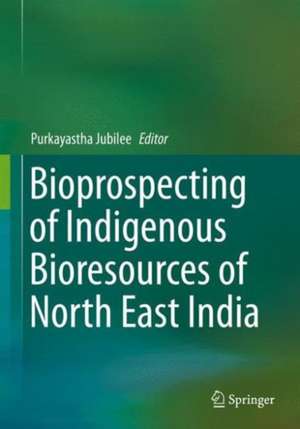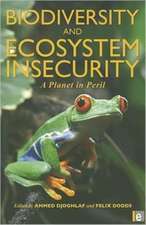Bioprospecting of Indigenous Bioresources of North-East India
Editat de Jubilee Purkayasthaen Limba Engleză Hardback – 24 aug 2016
The exploration, conservation and sustainable utilization of bioresources of world’s Megabiodiversity Hotspots are undeniable. North Eastern India is a recognised biodiversity hot spot where the evolutionary forces are at its optimum, making this region as centre of origin for many species. Although little bit exploratory studies have been conducted in this part of the globe but a scientific exploitation of the bioresources is almost lacking. Unscientific exploitation and overexploitation without proper knowledge of the bioresources may lead to imbalanced ecosystem of this mega diversity region. At the same time, very less exploration and exploitation will hamper biodiversity based development. Today, unscientific dramatic changes are underway in this region. Human activities are changing, degrading and destroying the bioresources in an unplanned manner. Scientific bioprospecting of the bioresources will boost the economy while ensuring conservation.
This book offers comprehensive information about various levels of bioprospecting of the gene pool of this Indo-Burma Mega Biodiversity Hot Spot, the North East India, which is endowed with huge biodiversity potential for exploration and exploitation for the benefit of humankind. Also, this book highlights the less and merely explored part of the indigenous biodiversity of North East India with explanation towards their better sustainable exploitation for benefit of the people, economy and environment.
The novelty of the book lies in expert coverage of the bioresources of this mega-diverse region including plants, microbes, insects etc. with provisions for their sustainable scientific utilization. This book portrays North East India as a melting pot of bioresources which are little explored and also those resources which are still to be explored. The book mainly highlights the bioprospecting approaches for North East Indian bioresources, and thus, it make itself a unique one in filling the knowledge gap that is there regarding the bioprospecting of the biodiversity of this special region on the earth. The book concludes by the ecotourism potential of this region. The target audiences for this book include biodiversity economists who are working on technology and bioresource management issues, and especially on biotechnology and biodiversity, development economists addressing the issues of bioresources in developing countries. These people may be in academia, in government, in non-governmental organizations and in private companies. The other target audiences group is policy scholars in government/public sectors who are interested in issues of biotechnology, IPRs, and biodiversity. In addition, scholars/experts in both development studies and resource management studies form another group of target audiences. Also, the book will be useful for the interaction between developed and developing nations regarding the issues of biodiversity and bioprospecting, as North Eastern India is the hub of Biodiversity.
| Toate formatele și edițiile | Preț | Express |
|---|---|---|
| Paperback (1) | 795.95 lei 38-44 zile | |
| Springer Nature Singapore – 21 apr 2018 | 795.95 lei 38-44 zile | |
| Hardback (1) | 966.45 lei 3-5 săpt. | |
| Springer Nature Singapore – 24 aug 2016 | 966.45 lei 3-5 săpt. |
Preț: 966.45 lei
Preț vechi: 1178.60 lei
-18% Nou
Puncte Express: 1450
Preț estimativ în valută:
184.93€ • 193.08$ • 153.05£
184.93€ • 193.08$ • 153.05£
Carte disponibilă
Livrare economică 15-29 martie
Preluare comenzi: 021 569.72.76
Specificații
ISBN-13: 9789811006197
ISBN-10: 9811006199
Pagini: 440
Ilustrații: XIX, 347 p. 90 illus., 42 illus. in color.
Dimensiuni: 178 x 254 x 25 mm
Greutate: 1.05 kg
Ediția:1st ed. 2016
Editura: Springer Nature Singapore
Colecția Springer
Locul publicării:Singapore, Singapore
ISBN-10: 9811006199
Pagini: 440
Ilustrații: XIX, 347 p. 90 illus., 42 illus. in color.
Dimensiuni: 178 x 254 x 25 mm
Greutate: 1.05 kg
Ediția:1st ed. 2016
Editura: Springer Nature Singapore
Colecția Springer
Locul publicării:Singapore, Singapore
Cuprins
Part I. Bioprospecting: Present and Future Prospects.- 1. Emerging Trends in Sustainable Bioprospecting of Bioresources.- 2. Bio-resources of North East India: Sustainable utilization and challenges.- Part II: Bioprospecting from Plant Resources of NE India.- 3. Endemic Orchids of North East India.- 4. Bioresources of Nagaland: A Case of Wild Edible Fruits in Khonoma Village Forest.- 5. Endemic Orchids and their conservation in North East India.- 6. Fibers and dye yielding plants of North East India.- 7. Pesticidal Plants of North East India.- 8. Biomass Resources for Biofuel Production in North-East India.- 9. Exploration and utilization of camouflaging plants for defence use with emphasis to North East India.- 10. Plant Products and Fermented Foods as Nutrition and Medicine in Manipur State of North-East India: Pharmacological Authenticity.- 11. Assessment of Genetic Diversity in Indigenous Plants in North East India by using Molecular Marker Technology.- Part III: Bioprospecting from Microbial Resources of NE India.- 12. Micromonospora: A potential source of Antibiotic.- 13. Algal wealth of North East India.- Part IV: Bioprospecting from Insect Resources of NE India.- 14. Drosophilid (Insecta, Diptera: Drosophilidae) Biodiversity of North-East India.- 15. Edible insects of North-east India.- 16. Endemic Thrips of North East India.- 17. Muga Silk- The Golden Thread of Assam.- 18. Mosquito biodiversity of North eastern India.- Part V: Sustainable Utilization of Important Bioresources of NE India.- 19. Non-Timber Forest Product (NTFP) in North East India: An Overview of Availability, Utilization and Conservation.- Part VI: Biotourism Potential of NE India.- 20. Prospects of Ecotourism in Majuli.- 21. Destination branding of Ziro through potentiality of bio tourism.- 22. Bio-tourism Potential in NE India.
Notă biografică
Dr. Jubilee Purkayastha is a Scientist with India’s Defence Research and Development Organization (DRDO) and currently holds the position of Joint Director in the Office of the Director General (Life Sciences). Dr. Purkayastha is a PhD in Life Sciences and is known for her contributions to the area of Plant Biotechnology, particularly in Proteomics and Genomics. Dr. Purkayastha has more than 25 research publications, 1 patent, 2 books and two awards to her credit. She is an expert reviewer for several International Peer Reviewed Journals like Ecotoxicology (Springer), Plos One, Acta Physiologiae Plantarum (Springer), Plant Molecular Biology Reporter (Springer) and also sits on the editorial board of several International Journals. In addition, she has several other research articles and book chapters to her credit.
Textul de pe ultima copertă
This work is a comprehensive information on the indigenous bioresources of North Eastern India with the scope of bioprospecting for discovery and commercialization of new sources and products and long-term ecological balance.
The exploration, conservation and sustainable utilization of bioresources of world’s Megabiodiversity Hotspots are undeniable. North Eastern India is a recognised biodiversity hot spot where the evolutionary forces are at its optimum, making this region as centre of origin for many species. Although little bit exploratory studies have been conducted in this part of the globe but a scientific exploitation of the bioresources is almost lacking. Unscientific exploitation and overexploitation without proper knowledge of the bioresources may lead to imbalanced ecosystem of this mega diversity region. At the same time, very less exploration and exploitation will hamper biodiversity based development. Today, unscientific dramatic changes are underway in this region. Human activities are changing, degrading and destroying the bioresources in an unplanned manner. Scientific bioprospecting of the bioresources will boost the economy while ensuring conservation.
This book offers comprehensive information about various levels of bioprospecting of the gene pool of this Indo-Burma Mega Biodiversity Hot Spot, the North East India, which is endowed with huge biodiversity potential for exploration and exploitation for the benefit of humankind. Also, this book highlights the less and merely explored part of the indigenous biodiversity of North East India with explanation towards their better sustainable exploitation for benefit of the people, economy and environment.
The novelty of the book lies in expert coverage of the bioresources of this mega-diverse region including plants, microbes, insects etc. with provisions for their sustainable scientific utilization. This book portrays North East India as a melting pot of bioresources which are little explored and also those resources which are still to be explored. The book mainly highlights the bioprospecting approaches for North East Indian bioresources, and thus, it make itself a unique one in filling the knowledge gap that is there regarding the bioprospecting of the biodiversity of this special region on the earth. The book concludes by the ecotourism potential of this region.
The target audiences for this book include biodiversity economists who are working on technology and bioresource management issues, and especially on biotechnology and biodiversity, development economists addressing the issues of bioresources in developing countries. These people may be in academia, in government, in non-governmental organizations and in private companies. The other target audiences group is policy scholars in government/public sectors who are interested in issues of biotechnology, IPRs, and biodiversity. In addition, scholars/experts in both development studies and resource management studies form another group of target audiences. Also, the book will be useful for the interaction between developed and developing nations regarding the issues of biodiversity and bioprospecting, as North Eastern India is the hub of Biodiversity.
The exploration, conservation and sustainable utilization of bioresources of world’s Megabiodiversity Hotspots are undeniable. North Eastern India is a recognised biodiversity hot spot where the evolutionary forces are at its optimum, making this region as centre of origin for many species. Although little bit exploratory studies have been conducted in this part of the globe but a scientific exploitation of the bioresources is almost lacking. Unscientific exploitation and overexploitation without proper knowledge of the bioresources may lead to imbalanced ecosystem of this mega diversity region. At the same time, very less exploration and exploitation will hamper biodiversity based development. Today, unscientific dramatic changes are underway in this region. Human activities are changing, degrading and destroying the bioresources in an unplanned manner. Scientific bioprospecting of the bioresources will boost the economy while ensuring conservation.
This book offers comprehensive information about various levels of bioprospecting of the gene pool of this Indo-Burma Mega Biodiversity Hot Spot, the North East India, which is endowed with huge biodiversity potential for exploration and exploitation for the benefit of humankind. Also, this book highlights the less and merely explored part of the indigenous biodiversity of North East India with explanation towards their better sustainable exploitation for benefit of the people, economy and environment.
The novelty of the book lies in expert coverage of the bioresources of this mega-diverse region including plants, microbes, insects etc. with provisions for their sustainable scientific utilization. This book portrays North East India as a melting pot of bioresources which are little explored and also those resources which are still to be explored. The book mainly highlights the bioprospecting approaches for North East Indian bioresources, and thus, it make itself a unique one in filling the knowledge gap that is there regarding the bioprospecting of the biodiversity of this special region on the earth. The book concludes by the ecotourism potential of this region.
The target audiences for this book include biodiversity economists who are working on technology and bioresource management issues, and especially on biotechnology and biodiversity, development economists addressing the issues of bioresources in developing countries. These people may be in academia, in government, in non-governmental organizations and in private companies. The other target audiences group is policy scholars in government/public sectors who are interested in issues of biotechnology, IPRs, and biodiversity. In addition, scholars/experts in both development studies and resource management studies form another group of target audiences. Also, the book will be useful for the interaction between developed and developing nations regarding the issues of biodiversity and bioprospecting, as North Eastern India is the hub of Biodiversity.
Caracteristici
Summarizes the status of explored biodiversity in North Eastern India
Presents contribution towards sustainable biodiversity exploration, and scientific conservation of mega diversity hot spot of India
Illustrates the role of technology in bio-prospecting of the vast diversity of mega-diversity rich region in India
Presents contribution towards sustainable biodiversity exploration, and scientific conservation of mega diversity hot spot of India
Illustrates the role of technology in bio-prospecting of the vast diversity of mega-diversity rich region in India








